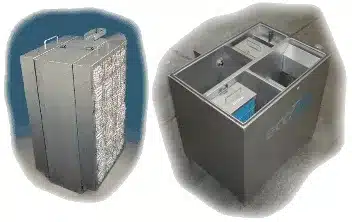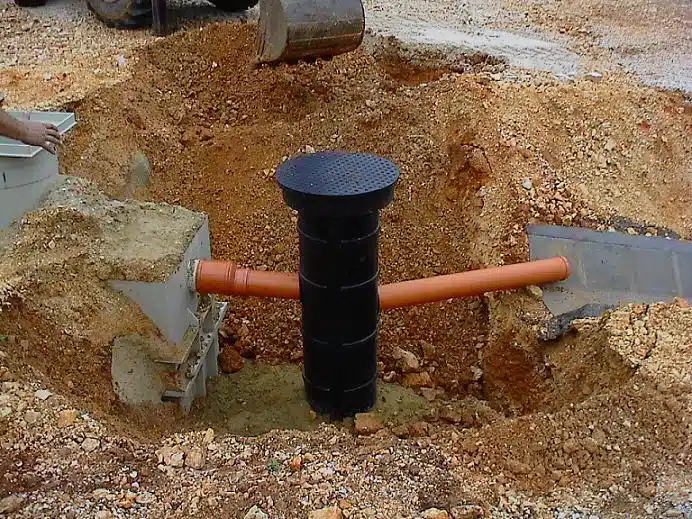Do you know about the hidden heroes under Vermont’s soil? Freytech Inc. Vermont Below Ground Oil Water Separators are key in keeping our water clean. They work underground, catching oil and grease before it can pollute our waterways.
These systems are a must for businesses that often deal with oily waste. They make sure these businesses follow the law and protect the environment. Getting them installed right is very important and needs careful planning.
Vermont takes protecting the environment seriously, and it shows in its strict rules on wastewater. Below ground oil water separators are a big part of this effort. They’re especially important for places like car repair shops, gas stations, and factories that often have oil and water mixtures.
Key Takeaways
- Vermont Below Ground Oil Water Separators protect waterways from pollutants
- These systems are crucial for businesses discharging oily wastewater
- Proper installation is essential for effective operation
- Oil water separators help businesses comply with local and state regulations
- They are particularly important for automotive, gas, and manufacturing industries
Introduction to Below Ground Oil Water Separators in Vermont
Below Ground Oil Water Separators are key in Vermont’s fight against pollution. They help manage wastewater from different places across the state. The rules in Vermont make sure these devices are set up and used right.
Definition and Purpose of Oil Water Separators
Oil water separators are systems made to take oil and grease out of wastewater. They let oil rise to the top while water goes down, making separation easy. This stops pollutants from getting into our water.
Importance in Vermont’s Environmental Regulations
Vermont is serious about protecting the environment. The state’s rules make many businesses put in and keep up oil water separators. These rules help keep Vermont’s waters and nature safe from oil spills. The Department of Environmental Conservation makes sure these rules are followed.
Types of Facilities Requiring Oil Water Separators
Many kinds of places in Vermont need oil water separators. This includes car washes, places that fix cars with drains, and spots for washing vehicles. Local laws often say these places must have these systems. By making businesses use oil water separators, Vermont makes them take care of their impact on the environment.
Vermont Below Ground Oil Water Separators: Regulatory Requirements
Vermont has strict rules for oil water separators to protect the environment. These rules are important for businesses and property owners who want to install or upgrade their systems. It’s key to know these rules before starting any project.
Permit Process for Installation
The permit process for installing oil water separators in Vermont depends on the facility type. New facilities must get a wastewater permit first. Existing facilities should talk to the Department of Environmental Conservation (DEC) to find out what permits they need. This ensures they follow Vermont’s oil water separator rules.
Local Sewer Ordinances and Compliance
Every town in Vermont has its own sewer rules for oil water separators. Property owners should check with their local town offices to see what these rules are. Following both state and local rules is important for compliance.
DEC Regional Office Involvement
The DEC helps oversee oil water separator installations in Vermont. They have offices in Barre, Essex, Springfield, Rutland, and St. Johnsbury. These offices offer guidance on rules and help with permits. Working with the right DEC office early can make the installation smoother and ensure it meets all state rules.
Design and Components of Underground Oil Water Separators
Underground oil water separators are key in managing industrial and commercial wastewater. They have several important parts to efficiently separate oil from water.
The main part of the separator is made from heavy-duty 304 stainless steel. This material is strong and doesn’t rust easily, which is important for working well in tough underground places.
A crucial part is the PVC coalescing media pack. It helps small oil droplets merge into bigger ones, making them easier to separate from water. The media pack is held in place by stainless steel anchors, keeping it working well for a long time.
The system also has an adjustable PVC oil skimmer with Viton O-rings. This skimmer takes out oil from the water’s surface, stopping it from moving further. Other parts include a sludge and grit chamber with a manual drain for easy solid removal.
For easy upkeep and use, the separator has a vent port, sump drain, cleanout port, and oil outlet port. These features help with ventilation, drainage, and cleaning access, keeping the system running well over time.
Installation Process for Below Ground Oil Water Separators
The process of installing oil water separators needs careful planning and precise steps. This ensures the system works well and meets local laws. Let’s look at the main parts of putting in these important devices.
Site Preparation and Excavation
First, the site must be prepared thoroughly. This means checking the area, marking where utilities are, and digging to the right depth. The hole must fit the oil water separator and allow for filling and packing down afterwards.
Proper Sizing and Capacity Considerations
Choosing the right size oil water separator is key for best performance. Things like flow rates, usually between 1 to 100 GPM for industrial setups, affect the size. Talking to plumbing experts or wastewater engineers helps pick the right size for your place.
Connection to Existing Drainage Systems
The last step is connecting the separator to current drainage systems. This needs to be done carefully to make sure water flows right and separates contaminants well. Making sure it fits with the existing plumbing is crucial for the separator to work as it should and follow the law.
Maintenance and Cleaning of Oil Water Separators
Keeping oil water separators in good shape is key. These systems need regular care to work well. The Vermont Department of Environmental Conservation recommends checking them every six to twelve months.
When looking after oil water separators, look for settled solids and floating oils. These can slow down the separator’s work. Cleaning is needed when these materials pile up. Experts use special vacuum trucks for this job.
It’s important to dispose of waste from oil water separators correctly. There are rules for liquid and solid waste with petroleum products. Regular sweeping and using absorbent materials can cut down on maintenance and costs.
By sticking to these maintenance steps, owners of oil water separators can keep Vermont’s environment safe. Regular care keeps the system efficient and follows local laws.
These separators are crucial in storm water systems. They process runoff to meet the US EPA’s Clean Water Act standards. With effective oily water treatment, facilities protect the environment and dodge big fines.
Freytech Inc.’s Enhanced Coalescing Technology for Oil Water Separation
Freytech Inc. leads in oil water separator technology. Their innovative methods set new standards in the industry. They are a top pick for businesses needing efficient solutions.
Achieving 5 PPM Separation Efficiency
Freytech’s separators for garages and other places hit a 5 PPM separation mark. This beats North American limits of 10 PPM. It ensures they meet strict environmental rules.
Separating Various Hydrocarbon Types
Freytech’s separators are versatile. They work well with many hydrocarbons like motor oil, diesel, gasoline, and jet fuel. This makes them useful across various industries.
Benefits of Freytech’s OWS Packages
Freytech’s oil water separator packages perform well. They separate free oil and trace amounts of emulsified oil. With 0.1 PPM efficiency, these systems offer top environmental protection. For businesses wanting to improve their oil water separation, contact Freytech Inc. at +1 (305) 372-1104.










